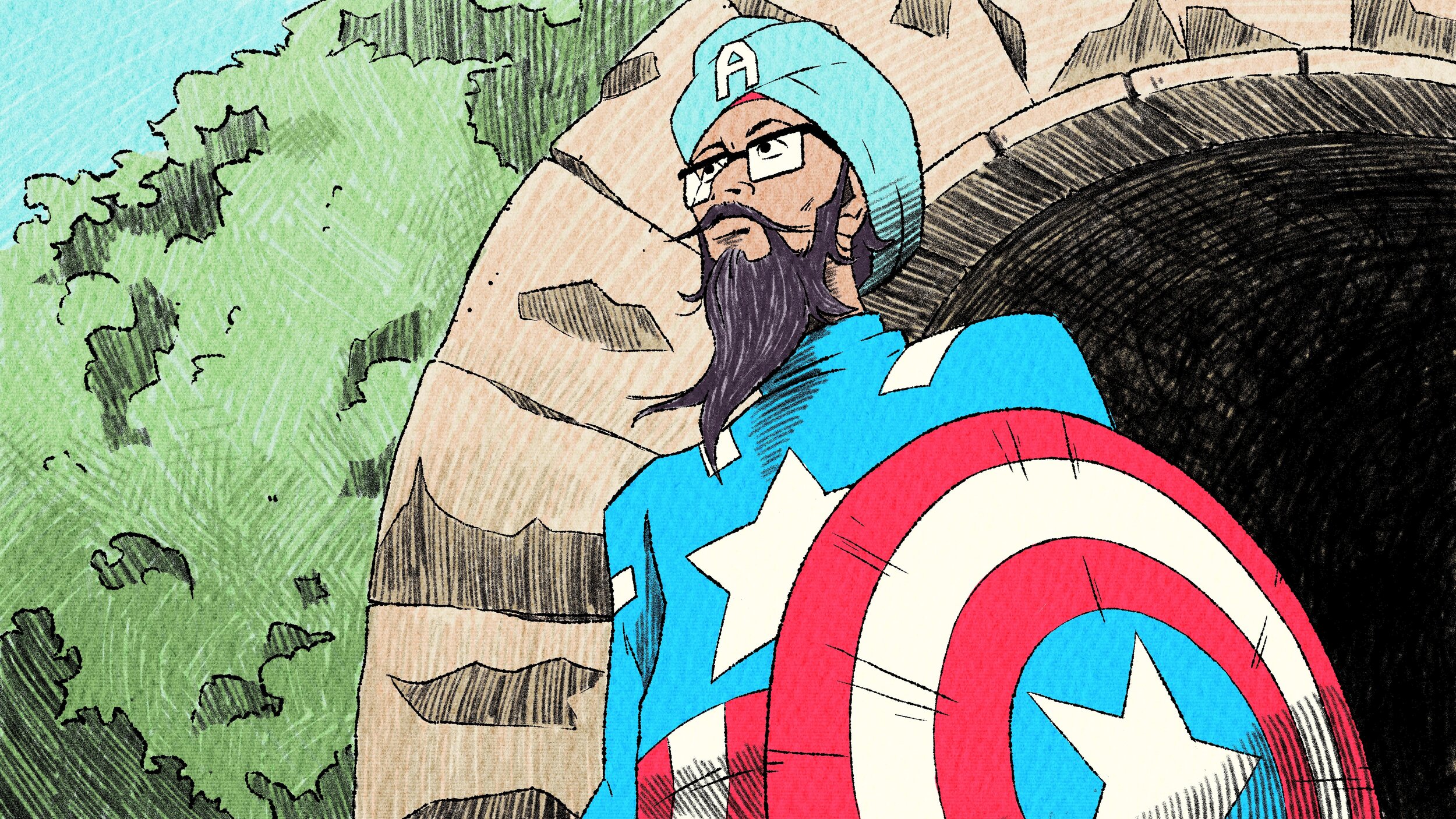Ryan Westra and Vishavjit Singh’s AMERICAN SIKH - the true and unlikely story of an American born, turban-wearing Sikh man who after a lifetime of facing prejudice, self-doubt and violence, finally finds acceptance in a superhero costume.
Vishavjit Singh is a South Asian American and Sikh man publicly known for his Sikh Captain America persona — his spin on the beloved patriotic character equipped with a turban and beard fighting against bigotry, intolerance and perceptions of what an American should look like. But Singh, the only member of his family born in the U.S., didn’t always feel he could embrace his identity this way. The 10-minute animated film follows Vishavjit’s life from the U.S. to India and back to the U.S. navigating genocide, post 9-11 hate crimes, and his own identity journey along the way.
The film garnered acclaim in the film festival circuit, securing a world premiere at The 2023 Tribeca Festival, winning Best Short Animation at Sidewalk Film Festival, Best Animation at San Diego International Film Festival, Best Documentary and Audience Choice Award at Tasveer Film Festival and other prestigious mentions. The film also saw incredible press coverage including features on Good Morning America, Forbes, CNN, Variety, as well as celebrity praise from Gurinder Chadha, A.R Rhaman, Deepak Chopra and more.
Following the incredible success of AMERICAN SIKH thus far, the animated short was released worldwide on YouTube on September 9th. As we mark the 23rd anniversary of the tragedy of 9/11, the film shares a new perspective on what it means to come together as a nation – capturing the struggle and hope on how we might overcome the persistent hate and violence towards fellow Americans who are judged as outsiders. In the aftermath of 9/11, people of color, particularly those from the Sikh community, have faced increased hate crimes and discrimination. AMERICAN SIKH highlights these challenges and emphasizes the importance of unity and understanding in the face of prejudice.
American Sikh is having a Great 2025 with Best Animation, Best Documentary, Best in Show and Gold in Diversity, Equity & Inclusion at Webby, Telly, Collision, w3, Davey and Anthem Awards!
Inspired by the incredible response to the film from audiences around the globe and powerful narrative themes of the film, Vishavjit worked with two teachers at Altair Education Consulting to create 11 lesson plans for grades 6-12 inspired by film themes of media representations, exploring identity, understanding post-9/11 perspectives, discovering the power of personal narrative and storytelling, assimilation versus belonging, understanding bias in contemporary society, and exploring implicit bias. You can find the lesson plans here.

This project matters.
Outside of India, there are very few Sikhs seen in media. Due to the lack of representation and the statistically small global population of Sikhs as a whole, the vast majority of Americans and the world at large know almost nothing about Sikhs. Lack of knowledge is not only an education and awareness issue, but historically is the root of many issues such as xenophobia, intolerance, racism and violent hate crimes.
What little knowledge people may have about Sikhs most often boils down to two things: a turban and a beard. It’s no secret that this surface-level depiction in American media is often the villain or the clown. This is the image that needs to be transformed - and that’s exactly what Sikh Captain America, Vishavjit Singh, is set out to do.
Meet the team.
Ryan Westra
Ryan Westra is Los Angeles-based director and cinematographer of documentary and commercial content. Ryan has worked with HBO Documentary Films, Verizon Wireless, Dreamworks, the Atlantic, the BBC, the Coachella Valley Music & Arts Festival, Panorama Music Festival, and has had his work featured on FunnyOrDie, Upworthy, The Huffington Post, and the BBC.
Vishavjit Singh
Vishavjit is a New York City based illustrator, performance artist, speaker and creator of Sikhtoons.com. He got his spark for cartooning in the post 9/11 tragedy when Americans with turbaned and bearded countenance became targets of hate/bias crimes. For the past few years he has been traveling across the US with his Captain America persona armed with turban, beard and humor to tackle fear, anxiety, bigotry and intolerance.
Studio Showoff
Studio Showoff is a Melbourne based production house founded by Ivan Dixon and Sean Zwan specializing in everything animation from boutique ad campaigns through to full TV series for children and adults alike. Credits include HBO, Childish Gambino, Twitch and more.

Why Animation?
There are many reasons why Vishavjit and I decided to make an animated film about the origin of Sikh Captain America. Firstly, it’s simply more unique. There are very few animated short films made each year and, therefore, these films are more likely to receive attention online, at film festivals, and even at the Oscars.
Secondly, animation has no expiration date. Unlike short films that use the cameras and technology of the day in which they were created, animated films continue to feel new and relevant decades after they’re completed.
Lastly, and most importantly, animation does a great job of taking emotionally heavy and violent subject matters (like the genocide in 1984 and the hate crimes following 9/11) and show them in a way that is easier for the audience to watch and understand. Live action documentaries that have been made in the past about 1984 especially have found it very difficult to reach large audiences and haven’t been very successful in raising awareness. We believe animation allows us the ability to touch on the reality of these topics in a way that is digestible and informative while still keeping the integrity of Vishavjit’s positive, inspiring story.














